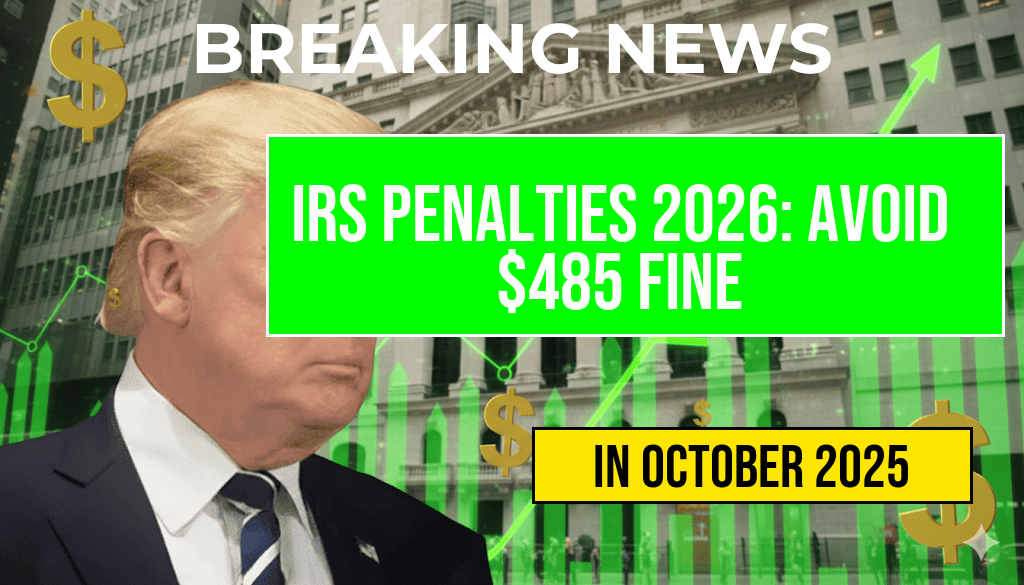IRS Penalties Increase in 2026: What Taxpayers Need to Know to Avoid a $485 Fine
As the 2026 tax season approaches, taxpayers should prepare for notable changes in IRS penalty policies, particularly regarding late-file penalties. The IRS has announced that starting in 2026, the penalty for failing to file a tax return on time will increase significantly, with some individuals facing fines up to $485 or more. This adjustment reflects the IRS’s ongoing efforts to enforce timely filing and collection efforts amidst evolving budget priorities.
Taxpayers who miss the filing deadline without requesting an extension could find themselves facing not only the late-filing penalty but also compounded charges if payments are late or incomplete. Experts recommend reviewing upcoming changes carefully and considering proactive steps, such as filing early or requesting extensions, to avoid additional financial burdens.
Understanding the New Late-File Penalty Structure
Beginning with the 2026 tax year, the IRS will implement a revised penalty schedule that increases the maximum fine for late filing. Previously, the penalty was capped at $435, but the new limit will rise to $485, adjusted annually for inflation. For taxpayers with higher income or complex returns, penalties can escalate further due to additional surcharges based on the amount owed and the duration of delay.
| Year | Maximum Penalty | Notes |
|---|---|---|
| 2025 | $435 | Base cap for late-filing penalty |
| 2026 | $485 | Adjusted for inflation; potential increases in subsequent years |
The penalty is calculated at 5% of the unpaid taxes for each month or part of a month that the return is late, up to a maximum of 25% of the unpaid amount. When combined with interest and other penalties, the total cost of late filing can become substantial.
Key Factors Influencing Penalty Severity
While the flat maximum penalty is a critical figure, several factors determine the actual penalty amount:
- Timeliness of Filing: Returns filed more than 60 days late may incur a minimum penalty of $435 or 100% of the unpaid tax, whichever is less.
- Amount Owed: Larger balances owed increase the potential penalty, especially if payments are also late.
- Reason for Delay: The IRS considers reasonable cause for delays, such as natural disasters or serious illness, which can mitigate penalties if properly documented.
- Frequency of Late Filings: Repeat offenders may face higher penalties and stricter enforcement actions.
Taxpayers should consult IRS guidelines or speak with a tax professional to understand how these factors might influence their specific situation.
Strategies to Avoid Penalties
Avoiding penalties requires proactive planning, especially as deadlines approach. Here are some practical steps:
- File Early: Submitting returns before April 15 or the designated deadline reduces the risk of late penalties and allows time to address any issues.
- Request an Extension: Filing for an extension grants additional time to submit the return, typically until October 15, but does not extend the time to pay any owed taxes.
- Pay Estimated Taxes: Making timely payments, even if filing is delayed, can minimize penalties related to unpaid balances.
- Maintain Accurate Records: Proper documentation can support claims for reasonable cause if penalties are contested.
- Seek Professional Advice: Complex situations may warrant guidance from tax professionals who can provide tailored strategies.
The IRS also offers penalty relief options under certain circumstances, such as natural disasters or other extraordinary hardships, which taxpayers should explore if applicable.
Implications for Taxpayers in 2026 and Beyond
The scheduled increases in late-file penalties underscore a broader shift toward stricter enforcement and revenue collection efforts by the IRS. As penalties become more punitive, the importance of timely filing and payment grows even more critical for individual and business taxpayers alike.
The IRS advises taxpayers to stay informed about upcoming changes through official channels, including the [IRS website](https://www.irs.gov/) and reputable tax news sources. Ensuring compliance not only helps avoid costly penalties but also maintains a clean tax record, which can be essential for future financial activities.
For detailed guidance on penalty assessment and relief options, the IRS provides resources and forms accessible online, including the [Form 843](https://www.irs.gov/forms-pubs/about-form-843) for requesting penalty abatement.
Additional Resources
- Wikipedia: Tax Penalty
- Forbes: How to Avoid Penalties When Filing Taxes
- IRS Payment Plans and Installment Agreements
Frequently Asked Questions
Question
What is the main reason for the increase in IRS late-file penalties in 2026?
Question
How much could I be fined if I file my taxes late in 2026?
In 2026, the late-file penalty can reach up to $485 per return, emphasizing the importance of timely filing to avoid this fine.
Question
Are there any exceptions or situations where I might avoid the late-file penalty?
Yes, you may avoid the late-file penalty if you have a reasonable cause for missing the deadline or if you submit a proper extension request.
Question
What steps can I take to prevent incurring penalties for late filing in 2026?
You should plan to file your taxes early, submit any necessary extensions, and ensure all documents are complete to avoid potential penalties.
Question
How do late-file penalties compare to late-payment penalties, and should I be concerned about both?
While late-file penalties can be up to $485, late-payment penalties accrue if taxes are unpaid after the deadline. It’s important to pay what you owe to minimize both types of penalties.

Leave a Reply